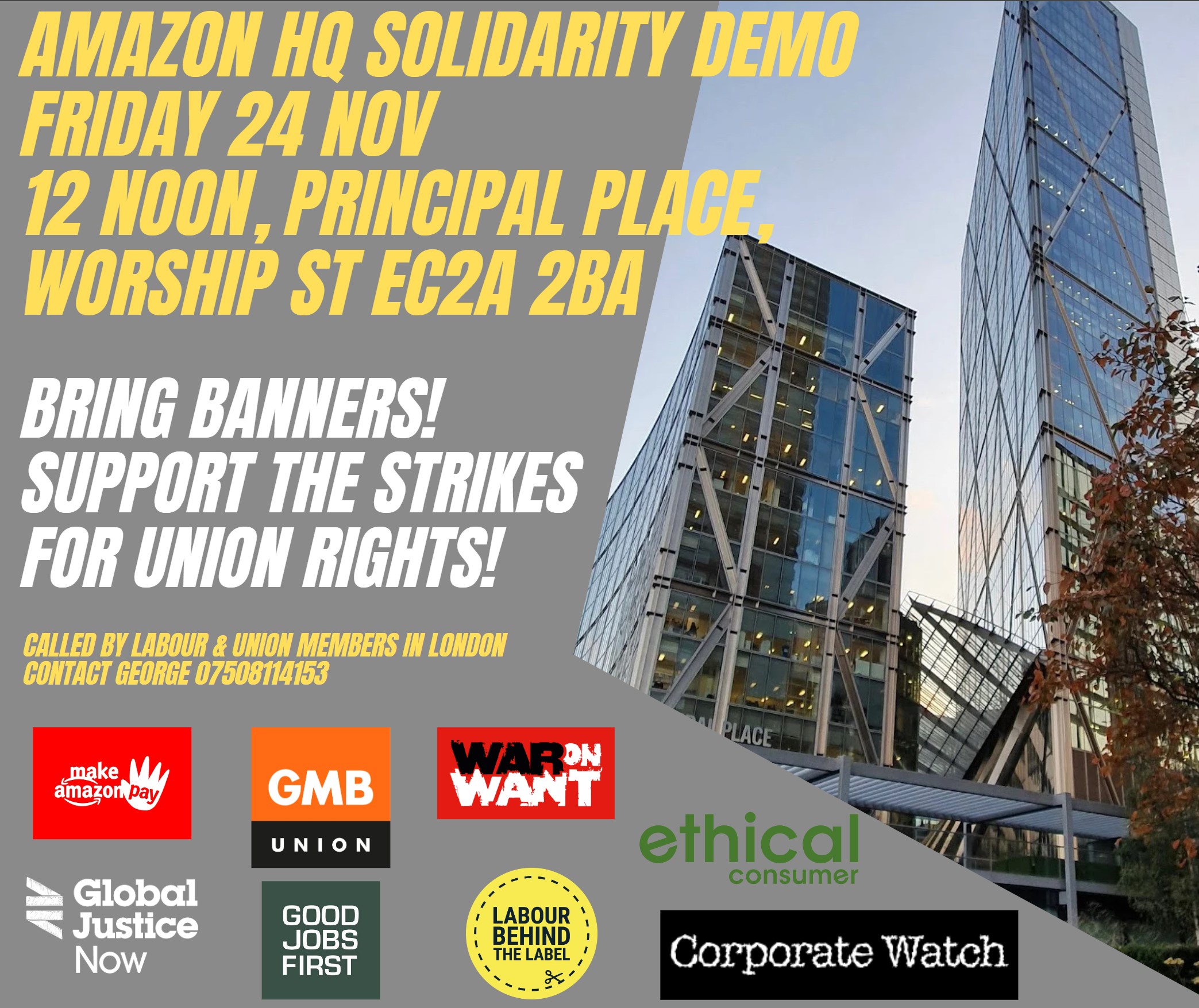It’s time to Make Amazon Pay: how you can take action on Black Friday

Amazon is one of the world’s largest companies and a high-tech pioneer in worker exploitation that has little regard for the profound environmental impact of its activities. Corporate Watch recently took part in the inaugural Make Amazon Pay summit in Manchester which brought together activists, campaigners, and trade unionists from around the world. Together we sought to determine what can be done to tackle Amazon.
A model of exploitation and abuse
Amazon’s global operations are built on treating workers as expendable and piling impossible workloads upon them, governed by algorithms and automation with no regard for the well-documented human cost. Trade union and elected representatives from across the globe at the Make Amazon Pay summit confirmed the persistence of these practices wherever Amazon operates.

In India alone, Amazon has 400 warehouses where millions of workers precariously fulfil work for the company, though only 300k are directly employed with just 3% on permanent contracts. Young, marginalised migrant workers move from rural areas to work 50-hour weeks with targets of processing 200 small items per hour for approximately $90-110 per month. Expectations that they work without breaks see workers fainting on the job and reporting kidney problems from avoiding going to the toilet as they try to meet targets.
The appalling conditions in Amazon’s UK warehouses have been repeatedly exposed over the last decade. A 2018 report by the GMB union revealed 600 ambulance callouts to Amazon warehouses in the previous three years with workers hospitalised in more than half of those cases. A survey of its members working in Amazon ‘fulfilment centres’ confirmed that 9 in 10 people experienced pain resulting from the workload imposed by the company. Ambulance callouts to Amazon rose to 971 between 2018 and 2021 with workers protesting that the company treated them like ‘slaves’, ‘robots’ and ‘rats’.
What action has Amazon taken to improve conditions for its workers since? On the first day of the Make Amazon Pay summit, it was revealed that the company had been attempting to cover up worker injuries arising from the physically damaging work it demands. In an effort to avoid negative media coverage about dangerous working conditions, Amazon has been forcing workers to call 999 themselves and make their own way to hospital, even in cases of serious injury such as broken limbs.
“Kill us or send us home.”
Even worse abuses were reported by Nepalese workers deceived into taking jobs with Amazon sub-contractors and subsequently exploited in Saudi Arabia. Amazon disregarded the risks of operating in Saudi Arabia, despite knowing of the acute problems of labour exploitation there.
As a result, workers paid fees to agents and then suffered abuses which Amnesty International said highly likely amounted to human trafficking. Amazon was shown to have repeatedly failed to act despite these workers raising their plight directly with the company. After being required to work in gruelling conditions to meet Amazon’s impossible targets, workers faced injury and ill health before being abandoned in dire housing conditions without the ability to work or leave the country. Trapped, workers were reported to have attempted suicide and were forced to incur further debts to return home.
Growth prioritised over action on climate breakdown
Amazon’s drive for permanent growth and profit-seeking has been criticised as incompatible with the urgent need to confront climate breakdown. Its stock market value is now $1.5trn (£1.2trn), and revenue for 2023 is expected to top $571bn (£457bn), exceeding the $514bn (£411bn) total for 2022. It has nearly 1.5m recognised employees, yet most are paid poverty wages. These figures represent significant growth since Corporate Watch covered Amazon’s exploitative business model back in 2018 as its ‘worth’ first surpassed $1trn (£800bn). At that point, revenues stood at $200bn (£160bn) and it had over half a million employees.
Despite being exposed for drastically undercounting its carbon footprint, Amazon’s climate emissions have still risen 40% since 2019. It has cancelled net-zero pledges like ‘shipment zero’, has no plans to reduce the impact of its use of air freight and, via Amazon Web Services, is even helping oil and gas companies to extract more fossil fuels.
Organised labour continues the fight
Strike actions against Amazon’s exploitative and environmentally damaging practices are ongoing across the globe. At the summit, people discussed how a string of collective bargaining and legislative victories have already been won, for example in Italy and Spain. Meanwhile in the US, Amazon Employees for Climate Justice (AECJ) staged a walkout of 1900 workers earlier this year.
The Make Amazon Pay summit heard from trade union representatives about ongoing disputes in California and Bangladesh taken by Teamsters delivery drivers and garment workers.
The fight escalates this Friday, November 24th, as workers worldwide will be taking strike action to Make Amazon Pay. Workers in Coventry will be joined by comrades from the US, Italy and Germany as they take their 28th day of strike action over pay and warehouse conditions.
How to take action this Black Friday
Black Friday, first imported to the UK by Amazon in 2010, is a celebration of insatiable consumerism at the expense of its workers and our future on this planet. Here are some of the actions you can take against Amazon’s destructive practices and stand in solidarity with workers:
- Reject limitless growth and consumerism by celebrating Buy Nothing Day instead.
- Actions are planned at Amazon offices and fulfilment centres across the country. Visit Make Amazon Pay to find the nearest action taking place to you,
- Join Corporate Watch at Amazon’s London HQ (1 Principal Pl, London EC2A 2FA) on Friday 24th at 12pm.

